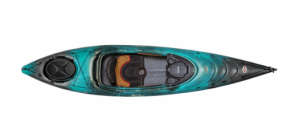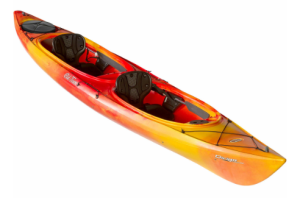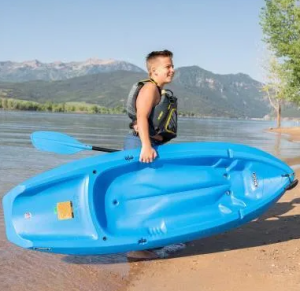Know Thy Paddle Craft
Sea kayaks. Recreational kayaks. SUPS. Canoes. Rowboats.
With so many kinds of paddle craft out there, it can be hard to know where to start, or which one can best help you achieve your paddling dreams. Read on to learn the difference between each type of vessel, and how and why to choose the one that’s right for you.
Kayaks
Kayaks are decked paddle craft in which the paddler sits low in the boat and propels it with a double-bladed paddle. They come in a wide variety of styles designed for different types of water, and can be single (solo) or double (tandem) seaters. Some categories of kayaks have a steering rudder controlled by the paddler’s feet. These days the most common kayaks are made of rotomolded plastic, though some are made of fiberglass, kevlar, wood, or other materials.
Sea Kayaks

P&H Delphin, a playful solo sea kayak
Sea kayaks (also known as expedition kayaks or touring kayaks) are long, high performance boats which have evolved from those first invented by Indigenous peoples, especially the Inuit of Greenland, for hunting whales and seals in often rough waters. They are fast, seaworthy, and designed to carry heavy loads. Sea kayaks can be used for both long, open paddles and island camping trips as well as for rough water play like surfing and exploring sea slots. Narrow, with rounded bottoms, they can feel tippy and unstable to beginner paddlers. However, this narrow shape allows experienced paddlers to hold them on an edge, making them more maneuverable despite their length, and able to react to waves and swell without capsizing. Modern sea kayaks are defined by a number of key features: length, rigging, compartments, and cockpit shape.
Length: 14 feet is usually considered the entry point for “true” sea kayaks. A solo will typically range from 15-18 feet, while tandem (and the rare triple) kayaks can be up to 25 feet in length.
Rigging: Sea kayaks typically have two different types of rigging on their deck for ease of use. The first is elastic bungees, which go across the deck and are used for holding down gear. The second is static line (aka rope) which forms a perimeter around the boat. This line is used in a number of different safety contexts: to help flip a capsized boat back over, connect a tow rope, anchor the boat in place, etc.
Seaward Legend, a fiberglass touring sea kayak
Hatches with sealed bulkheads: Sea kayaks are divided into separate compartments which provide both flotation in the event of a capsize (the boat flipping over) and space to store gear for camping trips. These compartments are separated from each other by waterproof walls called bulkheads, and are accessed via removable hatch covers. Sea kayaks will typically have four compartments, including the cockpit section where the paddler sits.
Cockpit Shape: Sea kayaks have cockpits (the area where the paddler sits) with an enclosed deck, which can be further sealed off with a sprayskirt, a piece of neoprene, vinyl, aquatherm, or other material worn around the paddler’s waste, which then wraps around the cockpit entrance creating a waterproof sealed area. This allows an experienced paddler to handle rougher conditions, put the boat further on its edge, and roll the kayak back up from a capsize without exiting the boat or causing it to flood.

Boreal Esperanto, a tandem sea kayak
Sea kayaks are used on all of Portland Paddle’s guided tours and lessons, and are available to renters with the capsize recovery and paddling experience necessary to use them safely. We offer both solo and tandem kayaks, and have kayaks designed for a range of experience levels, body sizes, and styles of paddling.
Recreational Kayaks

Old Town Loon, a recreational kayak

Old Town Dirigo, a tandem recreational kayak
Recreational kayaks are the most common kayaks, and they are what most people use when they kayak on a lake, pond or calm river. They are shorter than 14 feet, and have wide, stable bodies, and wide, open cockpits designed for comfort and ease of entry and exit. Some recreational kayaks have storage compartments for equipment, and they’re often fairly lightweight.
Recreational kayaks come in both solo and tandem styles at Portland Paddle, and are available at our East End Beach site, as well as for delivery for multi-day rentals. Recreational kayaks are great for paddling our “shore zone” (good for an hour or two of paddling) or in sheltered locations offsite, such as calm ponds and rivers, and marshy estuaries.
Sit On Top Kayaks

Old Town Twister, a sit on top kayak
Sit-on-top kayaks (SOTs) are a variation of recreational kayaks in which the paddler sits directly on top of the boat. There is no deck on a SOT and no cockpit, which makes it easier to enter and exit the boat. On the other hand, SOTs generally involve a wetter ride for the paddler, since there is no deck to protect from paddle drips and waves. SOT kayaks are the widest and flattest kayaks, making them extremely stable in their normal position, but unable to be put on an edge for performance paddling. The stability and ease of access to gear makes them ideal for activities like birding and photography. But they are heavier and a bit more awkward to carry than regular recreational kayaks. Recreational sit-on -ops should also not be confused with surfskis: extremely long and narrow, high performance sea kayaks which also use a sit-on-top cockpit method.
We use sit-on-top kayaks at our Crescent Beach location in Cape Elizabeth! Our youth-specific kayaks are also sit-on-tops, and are available at both Crescent Beach and East End Beach, as well as for delivery.

Lifetime Wave, a youth-specific sit-on-top kayak
